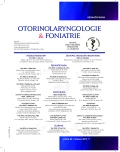New Risk Factors for Respiratory Papillomatosis
Authors:
M. Formánek 1,2; Karol Zeleník 1,2
; R. Tomanová 3; Pavel Komínek 1,2
Authors‘ workplace:
Klinika otorinolaryngologie a chirurgie hlavy a krku FN Ostrava
přednosta prof. MUDr. P. Komínek, Ph. D., MBA
1; Katedra kraniofaciálních oborů, Lékařská fakulta, Ostravská Univerzita
vedoucí katedry prof. MUDr. P. Komínek, Ph. D., MBA
2; Ústav patologie FN Ostrava
přednostka doc. MUDr. J. Dvořáčková, Ph. D.
3
Published in:
Otorinolaryngol Foniatr, 66, 2017, No. 1, pp. 23-27.
Category:
Original Article
Overview
Background:
Recurrent respiratory papillomatosis is caused by human papillomavirus. However, the prevalence of respiratory papillomatosis is much lower than prevalence of human papillomavirus infection. Therefore other factors may contribute to recurrent respiratory papillomatosis. This study investigated whether patients with respiratory papillomatosis are more often infected with herpes simplex virus type 2 and chlamydia trachomatis and whether they more often have laryngopharyngeal reflux.
Methods:
The prospective case-control study included 27 patients with recurrent respiratory papillomatosis and 27 patients with no pathology of laryngeal mucosa (control group). Immunohistochemical analysis of pepsin, human papillomavirus, herpes simplex virus type 2, and chlamydia trachomatis was performed in biopsy specimens of laryngeal papillomas and of healthy laryngeal mucosa (control group) obtained during microlaryngoscopy procedures.
Results:
Pathologic laryngopharyngeal reflux (pepsin in tissue) was diagnosed in 13/27 (48.1%) patients with papillomatosis and in 0/27 control patients (P < 0.001). Herpes simplex virus type 2 was present in 12/27 (44.4%) patients with papillomatosis and in 1/27 (3.7%) control patients (P = 0.001). Seven specimens were positive for both pepsin and herpes simplex virus type 2. No samples were positive for chlamydia trachomatis. The groups were homogenous.
Conclusions:
Laryngopharyngeal reflux and herpes simplex virus type 2 infection could be possible risk factors for recurrent respiratory papillomatosis.
Keywords:
recurrent respiratory papillomatosis, human papillomavirus, laryngopharyngeal reflux, herpes simplex virus type 2
Sources
1. Bednář, M., Fraňková, V., Schindler, J. et al.: Lékařská mikrobiologie. První vydání. Praha, Triton. 1996. ISBN-10 : 80-2380-297-6.
2. Gillison, M. L., Broutian, T., Pickard, R. K. et al.: Prevalence of oral HPV infection in the United States, 2009-2010. JAMA, 307, 2012, 7, s. 693-700.
3. Holland, B. W., Koufman, J. A., Postma, G. N. et al.: Laryngopharyngeal reflux and laryngeal web formation in patients with pediatric recurrent respiratory papillomas. Laryngoscope, 112, 2002, 11, s. 1926-1929.
4. Hugo, J., Vokurka, M.: Velký lékařský slovník. 9. vydání. Praha, Maxdorf. 2010. ISBN 978-80-7345-202-5.
5. Lang Kuhs, K. A., Gonzalez, P., Struijk, L. et al.: Prevalence of and risk factors for oral human papillomavirus among young women in Costa Rica. J. Infect. Dis., 208, 2013, 10, s. 1643-1652.
6. Lindeberg, H., Johansen, L.: The presence of human papillomavirus (HPV) in solitary adult laryngeal papillomas demonstrated by in-situ DNA hybridization with sulphonated probes. Clin. Otolaryngol. Allied. Sci., 15, 1990, 4, s. 367-371.
7. McKenna, M., Brodsky, L.: Extraesophageal acid reflux and recurrent respiratory papilloma in children. Int. J. Pediatr. Otorhinolaryngol., 69, 2005, 5, s. 597-605.
8. Miller, C. S., Danaher, R. J.: Asymptomatic shedding of herpes simplex virus (HSV) in the oral cavity. Oral Surg. Oral Med. Oral Pathol. Oral Radiol. Endod, 105, 2008, 1, s. 43-50.
9. Rautava, J., Willberg, J., Louvanto, K. et. al.: Prevalence, genotype distribution and persistence of human papillomavirus in oral mucosa of women: A six-year follow-up study. PLoS One, 7, 2012, 8, e42171.
10. Rintala, M. A., Grénman, S. E., Järvenkylä, M. E. et al.: High-Risk types of human papillomavirus (HPV) DNA in oral and genital mucosa of infants during their first 3 xears of life: Experience from the finnish HPV family study. Clin. Infect. Dis., 41, 2005, 12, s. 1728-1733.
11. Safaeian, M., Quint, K., Schiffman, M. et al.: Chlamydia trachomatis and risk of prevalent and incident cervical premalignancy in a population-based cohort. J. Natl. Cancer Inst., 102, 2010, 23, s. 1794-1804.
12. Samoff, E., Koumans, E. H., Markowitz, L. E. et al.: Association of Chlamydia trachomatis with persistence of high-risk types of human papillomavirus in a cohort of female adolescents. Am. J. Epidemiol., 162, 2005, 7, s. 668-765.
13. Shew, M. L., Fortenberry, J. D., Tu, W. et al.: Association of condom use, sexual behaviors, and sexually transmitted infections with the duration of genital human papillomavirus infection among adolescent women. Arch. Pediatr. Adolesc. Med, 160, 2006, 2, s. 151-156.
14. Silins, I., Ryd, W., Strand, A. et al.: Chlamydia trachomatis infection and persistence of human papillomavirus. Int. J. Cancer, 116, 2005, 1, s. 110-115.
15. Smith, J. S., Herrero, R., Bosetti, C. et al.: Herpes simplex virus-2 as a human papillomavirus cofactor in the etiology of invasive cervical cancer. J. Natl. Cancer Inst., 94, 2002, 21, s. 1604-1613.
16. Szydłowski, J., Jonczyk-Potoczna, K., Pucher, B. et al.: Prevalence of human papillomavirus (HPV) in upper respiratory tract mucosa in a group of pre-school children. Ann. Agric. Environ. Med., 21, 2014, 4, s. 822-824.
17. Vriend, H. J., Bogaards, J. A., van Bergen, J. E. A. M. et al.: Incidence and persistence of carcinogenic genital human papillomavirus infections in young women with or without Chlamydia trachomatis co-infection. Cancer Medicine, 4, 2015, 10, s. 1589-1598.
18. Whitley, R. J., Roizman, B.: Herpes simplex virus infections. Lancet, 357, 2001, 9267, s. 1513-1518.
19. Zeleník, K., Čáp, P., Chlumský, J. et al.: Mimojícnové projevy refluxní choroby. První vydání. Havlíčkův Brod: Tobiáš. 2013. ISBN 978-80-7311-138-0.
20. Zhao, Y., Cao, X., Zheng, Y. et al.: Relationship between cervical disease and infection with human papillomavirus types 16 and 18, and herpes simplex virus 1 and 2. J. Med. Virol, 84, 2012, 12, s. 1920-19277.
Labels
Audiology Paediatric ENT ENT (Otorhinolaryngology)Article was published in
Otorhinolaryngology and Phoniatrics

2017 Issue 1
Most read in this issue
- Plain Radiography of Paranasal Sinuses: Its Value in Diagnosis of Acute Rhinosinusitis and Current Possible Indications
- Deep Neck Infections as a Complication of Pharyngeal Inflammation
- Histological and Histochemical Analysis of Retraction Pocket Pars Tensa of Tympanic Membrane in Children
- Verification of the Impact of Hyperbaric Oxygen Therapy in the Treatment of Sudden Sensorineural Hearing Loss
